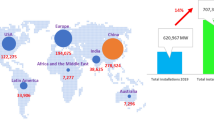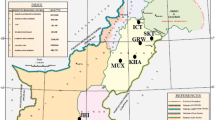Abstract
An important parameter to quantitatively assess the performance of a wind farm is its capacity factor. This study presents an analytical model to determine the capacity factor of a wind farm using the Weibull probability distribution function according to the local wind speed associated with the characteristics of the selected wind turbine. The model is based on the analytical integral of the wind energy characteristics calculated in relation to the wind speed probability distribution. The model allows determining the best rated speed for the wind turbine considering the local wind characteristic. The study has also introduced an analytical method for the wind turbine selection in order to maximize the plant’s capacity factor. In addition, the model allows determining the turbine operating time in each of the regions of the power curve. Knowing the distribution of operating time is useful for formulating failure monitoring strategies and operation and maintenance (O&M) planning. The proposed model has been validated by experimental results obtained in a wind farm in Southern Brazil.













Similar content being viewed by others
References
Albadi, M. H., & El-Saadany, E. F. (2009). Novel method for estimating the CF of variable speed wind turbines. In: Proceedings of the 2009 IEEE Power And Energy Society General Meeting, Pes ’09, pp. 1–6.
Alstom. (2019). Eco 100 Platform & Powerof3-Alstom-Page-Pdf Catalogs | Documentation | Brochures. Disponível Em. https://pdf.archiexpo.com/pdf/alstom/eco-100-platform-powerof3/88574-142463-_4.html. Acesso Em: 21 Dez.
Bardal, L. M., & Saetran, L. R. (2017). Influence of turbulence intensity on wind turbine power curves. Energy Procedia, 137, 553–558.
Caldas, D. M. (2010). Estudo do potencial eólico e estimativa de geração de energia de um projeto eólico na cidade Do Rio De Janeiro Utilizando O Windpro E O Wasp. [S.L.] Universidade Federal Do Rio De Janeiro - (Ufrj).
Camargo, S., et al. (2019). Atlas Eólico E Solar: Ceará 2019. Curitiba: Camargo Schubert; Fortaleza: Adece, Fiec, Sebrae
Camelo, H., Do, N., et al. (2008). Análise estatística da velocidade de vento do estado do ceará. Revista De Tecnologia Fortaleza, 29(2), 211–223.
Carrillo, C., et al. (2013). Review of power curve modelling for windturbines. Renewable and Sustainable Energy Reviews, 21, 572–581.
Carta, J. A., Ramírez, P., & Velázquez, S. (2009). A Review of wind speed probability distributions used in wind energy analysis case studies in the canary Islands. Renewable and Sustainable Energy Reviews, 13, 933–955.
Coelba. (2001). Atlas Do Potencial Eólico Do Estado Da Bahia
Cosern, C. E., Do R. G., & Do N. (2003). Potêncial eólico do estado do rio grande do norte. Disponível Em. http://www.cresesb.cepel.br/publicacoes/download/atlas_eolico/atlas_eolico_rn.pdf
Diyoke, C. (2019). A new approximate capacity factor method for matching wind turbines to a site: case study of Humber region, Uk. International Journal of Energy and Environmental Engineering, 10(4), 451–462.
Dos Santos, P. M. D. (2015). Procedimento Para Prospecção De Potencial Eólico Com Auxilio De Sistemas De Informação Geográfica. [S.L.] Universidade Federal De Itajubá (Unifei).
Enercon. (2014). Gama De Produtos Enercon.
Epe, E., & De P. E. (2020). Web map epe: sistema de informações geográficas do setor energético Brasileiro. Disponível Em. https://gisepeprd.epe.gov.br/webmapepe/. Acesso Em: 29 Maio. 2020.
Ge. (2011). Introducing Ge’s 1.6–100.
Iec, I. E. C. Iec 61400–12–1 Wind Energy Generation Systems – Part 1 2–1 : Power Performance Measurements Of Electricity Producing Wind Turbines. [S.L: S.N.].
Jangamshetti, S. H., & Guruprasada Rau, V. (2001). Normalized power curves as a tool for identification of optimum wind turbine generator parameters. IEEE Transactions on Energy Conversion, 16(3), 283–288.
Krohn, S., Morthorst, P.-E., & Awerbuch, S. (2009). The economics of wind energy. The European Wind Energy Association, 21(2), 100–109.
Langreder, W., et al. (2004). Turbulence Correction for Power Curves., 1, 2–4.
Mme, M., & De Minas, E. E. (2015). Energia Eólica No Brasil E Mundo O Homem E A Energia Do Vento Entraves E Soluções Inclusão Social Nos Parques. Boletim Mensal De Energia, 55(61), 8–11.
Camargo Schubert. (2014). Atlas Eólio: rio grande do sulporto alegre. Disponível Em. http://www.cresesb.cepel.br/publicacoes/download/atlas_eolico/atlas_do_potencial_eolico_do_estado_do_riograndedosul(2014).pdf
Silva, H. B. (2018). Técnicas Para Redução De Dimensionalidade De Séries Temporais E Detecção De Velocidades Extremas Do Vento Para Geração Eólica. [S.L.] Universidade Federal De Pernambuco (Ufpe)
Silva, J. A. D. (2013). Análise De Risco Da Entrega Da Energia Eólica Contratada Através De Leilões De Energia No Brasil. [S.L.] Universidade Federal De Itajubá (Unifei).
Sohoni, V., Gupta, S. C., & Nema, R. K. (2016). (2016) A critical review on wind turbine power curve modelling techniques and their applications in wind based energy systems. Journal of Energy, 4, 1–18.
Suzlon. (2004). Wind Turbine S.88 - 2.1 Mw.
Vestas. (2014). Catalog V82–1.65 Mw.
Acknowledgements
This study was financed in part by the Coordenação de Aperfeiçoamento de Pessoal de Nível Superior - Brasil (CAPES) - Finance Code 001. We would like to thank the engineer Thadeu Carneiro da Silva, for providing data from Senandes III and Vento Aragano I wind farms for the model validation.
Author information
Authors and Affiliations
Corresponding author
Additional information
Publisher's Note
Springer Nature remains neutral with regard to jurisdictional claims in published maps and institutional affiliations.
Appendices
Appendix
To compute the capacity factor, we calculated the integral of the product between the power associated with the wind speed \(v\left( {P\left( v \right)} \right)\) and its probability of occurrence \(f\left( {v,c,k} \right)\), dividing the result by the rated power of the wind turbine.
This integral can be divided into four parts:
with \(f\) being the Weilbull's probability density function, the integral that determines Fc becomes:
designate
Therefore,
Defining pu wind values and pu power:
Integrating regions II and III separately, we have:
REGION II
Changing the variables:
the primitive, just for the integral, is
Since the gamma function is incomplete
Therefore,
REGION III
In region III, the integral is simpler, as it is only the integral of the Weibull function.
Therefore,
Rights and permissions
About this article
Cite this article
de Lira Teixeira, V., Hetem, A., Bruzinga, G.R. et al. Analytical Model for the Wind Farm Capacity Factor Based on Local Wind Characteristics. J Control Autom Electr Syst 32, 1389–1398 (2021). https://doi.org/10.1007/s40313-021-00737-6
Received:
Revised:
Accepted:
Published:
Issue Date:
DOI: https://doi.org/10.1007/s40313-021-00737-6




